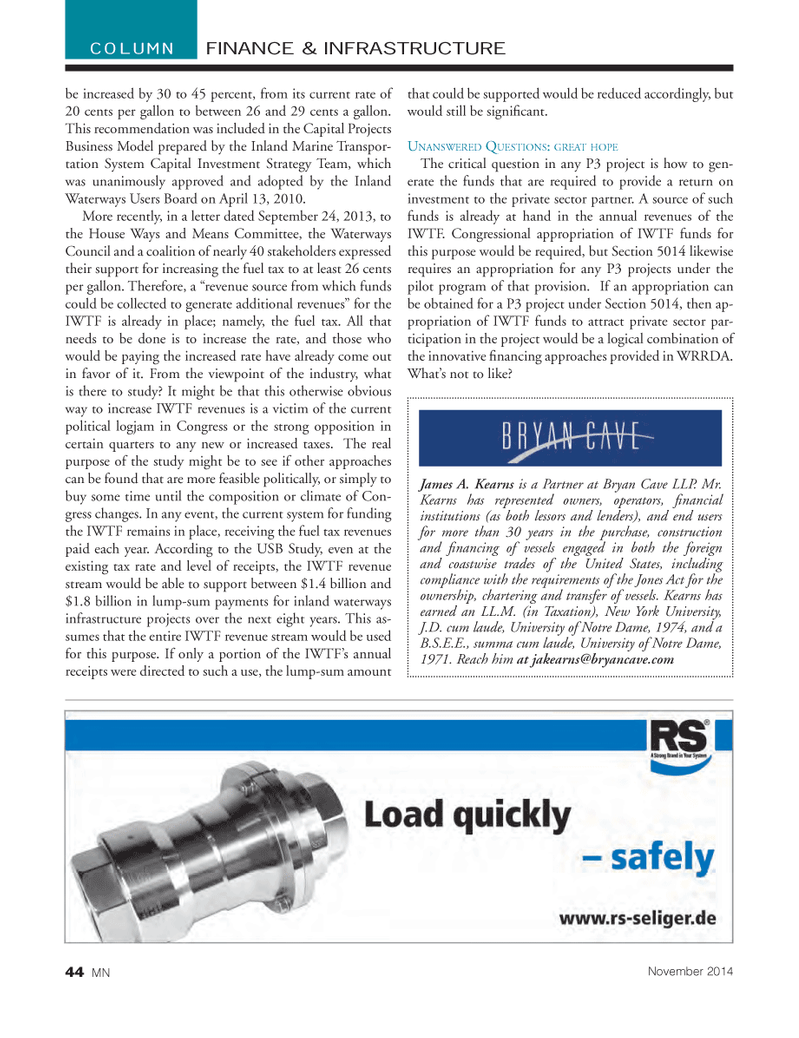
Page 44: of Marine News Magazine (November 2014)
Workboat Annual
Read this page in Pdf, Flash or Html5 edition of November 2014 Marine News Magazine
be increased by 30 to 45 percent, from its current rate of 20 cents per gallon to between 26 and 29 cents a gallon.
This recommendation was included in the Capital Projects
Business Model prepared by the Inland Marine Transpor- tation System Capital Investment Strategy Team, which was unanimously approved and adopted by the Inland
Waterways Users Board on April 13, 2010. More recently, in a letter dated September 24, 2013, to the House Ways and Means Committee, the Waterways
Council and a coalition of nearly 40 stakeholders expressed their support for increasing the fuel tax to at least 26 cents per gallon. Therefore, a “revenue source from which funds could be collected to generate additional revenues” for the
IWTF is already in place; namely, the fuel tax. All that needs to be done is to increase the rate, and those who would be paying the increased rate have already come out in favor of it. From the viewpoint of the industry, what is there to study? It might be that this otherwise obvious way to increase IWTF revenues is a victim of the current political logjam in Congress or the strong opposition in certain quarters to any new or increased taxes. The real purpose of the study might be to see if other approaches can be found that are more feasible politically, or simply to buy some time until the composition or climate of Con- gress changes. In any event, the current system for funding the IWTF remains in place, receiving the fuel tax revenues paid each year. According to the USB Study, even at the existing tax rate and level of receipts, the IWTF revenue stream would be able to support between $1.4 billion and $1.8 billion in lump-sum payments for inland waterways infrastructure projects over the next eight years. This as- sumes that the entire IWTF revenue stream would be used for this purpose. If only a portion of the IWTF’s annual receipts were directed to such a use, the lump-sum amount that could be supported would be reduced accordingly, but would still be signifi cant.
UNANSWERED QUESTIONS: GREAT HOPE
The critical question in any P3 project is how to gen- erate the funds that are required to provide a return on investment to the private sector partner. A source of such funds is already at hand in the annual revenues of the
IWTF. Congressional appropriation of IWTF funds for this purpose would be required, but Section 5014 likewise requires an appropriation for any P3 projects under the pilot program of that provision. If an appropriation can be obtained for a P3 project under Section 5014, then ap- propriation of IWTF funds to attract private sector par- ticipation in the project would be a logical combination of the innovative fi nancing approaches provided in WRRDA.
What’s not to like?
FINANCE & INFRASTRUCTURECOLUMN
James A. Kearns is a Partner at Bryan Cave LLP. Mr.
Kearns has represented owners, operators, fi nancial institutions (as both lessors and lenders), and end users for more than 30 years in the purchase, construction and fi nancing of vessels engaged in both the foreign and coastwise trades of the United States, including compliance with the requirements of the Jones Act for the ownership, chartering and transfer of vessels. Kearns has earned an LL.M. (in Taxation), New York University,
J.D. cum laude, University of Notre Dame, 1974, and a
B.S.E.E., summa cum laude, University of Notre Dame, 1971. Reach him at [email protected]
November 2014 44 MN
MN Nov14 Layout 32-49.indd 44 10/24/2014 2:47:15 PM

 43
43

 45
45
